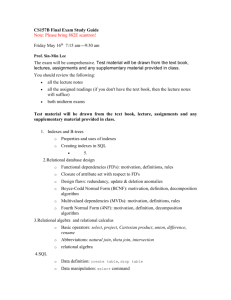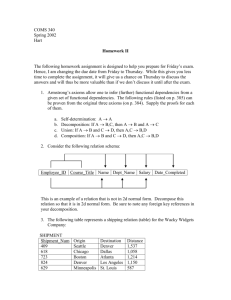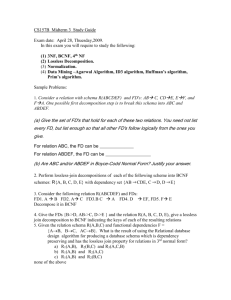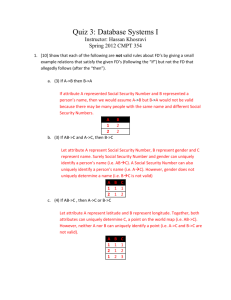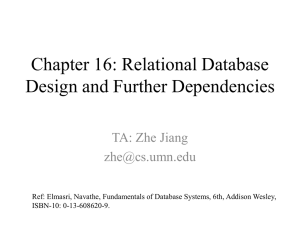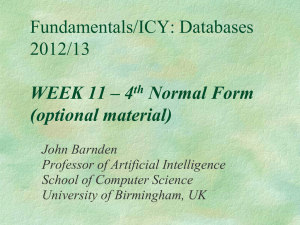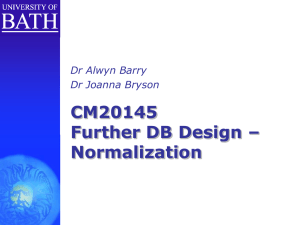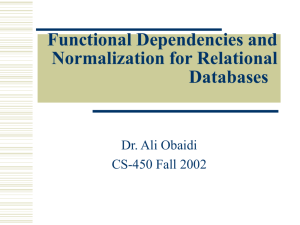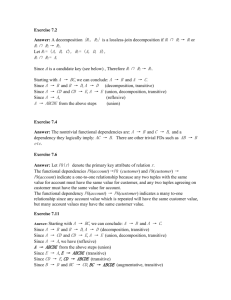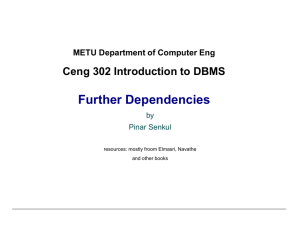28SpCS157B Final Exam Study Guide
advertisement
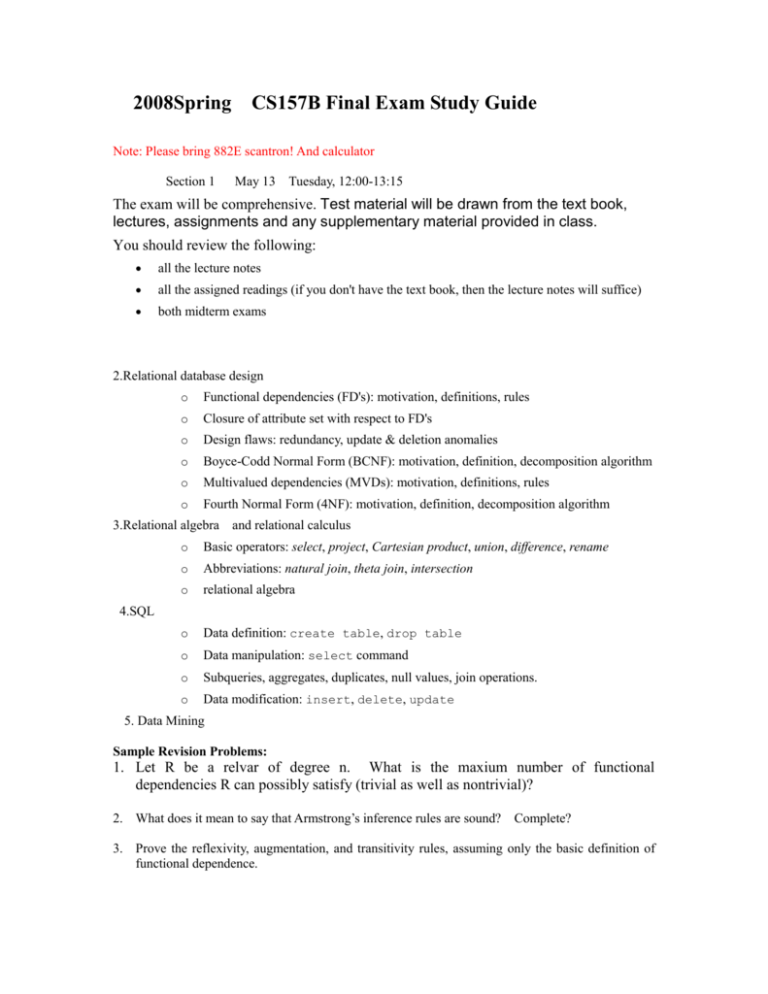
2008Spring
CS157B Final Exam Study Guide
Note: Please bring 882E scantron! And calculator
Section 1
May 13 Tuesday, 12:00-13:15
The exam will be comprehensive. Test material will be drawn from the text book,
lectures, assignments and any supplementary material provided in class.
You should review the following:
all the lecture notes
all the assigned readings (if you don't have the text book, then the lecture notes will suffice)
both midterm exams
2.Relational database design
o
Functional dependencies (FD's): motivation, definitions, rules
o
Closure of attribute set with respect to FD's
o
Design flaws: redundancy, update & deletion anomalies
o
Boyce-Codd Normal Form (BCNF): motivation, definition, decomposition algorithm
o
Multivalued dependencies (MVDs): motivation, definitions, rules
o
Fourth Normal Form (4NF): motivation, definition, decomposition algorithm
3.Relational algebra and relational calculus
o
Basic operators: select, project, Cartesian product, union, difference, rename
o
Abbreviations: natural join, theta join, intersection
o
relational algebra
o
Data definition: create table, drop table
o
Data manipulation: select command
o
Subqueries, aggregates, duplicates, null values, join operations.
o
Data modification: insert, delete, update
4.SQL
5. Data Mining
Sample Revision Problems:
1. Let R be a relvar of degree n. What is the maxium number of functional
dependencies R can possibly satisfy (trivial as well as nontrivial)?
2. What does it mean to say that Armstrong’s inference rules are sound? Complete?
3. Prove the reflexivity, augmentation, and transitivity rules, assuming only the basic definition of
functional dependence.
4. Define (a) the closure of a set of FDs; (b) the closure of a set of attributes under a set of FDs.
5. Relvar R{ A, B, C, D, E, F, G} satisfies the following FDs:
A B
BC DE
AEF G
Compute the closure {A, C} under this set of FDs. Is the FDACF DG implied by this set?
6. What does it mean to say that two sets S1 and S2 of FD are equivalent?
7. What does it mean to say that a set of FDs is irreducible?
8. Here are two sets of FDs for a relvar R{A, B, C, D, E}. Are they equivalent?
1. A B
AB C D AC D E
2. A BC D AE
9. Relvar R{ A, B, C, D, E, F} satisfies the following FDs:
AB C
C
A
BC D
ACD B
BE C
CE FA
CF BD
D EF
Find an irreducible equvalent for this set of FDs.
10. A relvar TIMETABLE is defined with the following attributes:
D Day of the week (1 to 5)
P Period within day (1 to 8)
C Classroom number
T Teacher name
L Lsson name
The tuple { D:d, P:p, C:c, T:t, L:l}appears in this relvar if and only if at time { D:d, P:p} lesson l is
taught by teacher t in classroom c. You can assume that lessons are one period in duration and that
every lesson has a name that is unique with respect to all lessons taught in the week. What
functional dpendencies hold in this relvar? What are the candidate key?
11. Consider the relation R(ABCDE) with FDs:
FD1: AB -> D, FD2. AB->E, FD3. D->A, and FD4. D->B.
The number of keys of R is:
(a) 1 (b) 2 (c) 3 (d) 10
12. Suppose that we decompose the schema R = (A ,B, C, D, E) into
(A, B, C)
(A, D, E).
Show that this decomposition is a looseless-join decomposition if the following set F of
functional dependencies holds:
A BC
CD E
BD
EA
13. Show that the following decomposition of schema of
looseless-join decomposition:
Exercise.1 is not a
(A, B, C)
(C, D, E).
Hint : Give an example of a relation r on schema R such that
A, B, C
(r)
C, D, E
r
(r)
14. Use the definition of multivalued dependency to argue that each of the following axioms is sound:
(a) The complementation rule.
(b) The multivalued argumentation rule
(c) The multivalued transitivity rule.
(d) The difference rule.
15. Use the definitions of multivalued dependency and functional dependency to show the soundness
of the replication rule.
16. Show that the coalescence rule is sound. ( Hint: Apply the definition of to a pair of
tuples t1 and t2 such that t1 [] = t2 []. Observe that since = , if two tuples have the
same value on R - , then they have the same value on .)
17. Let R = (A, B, C, D, E ), and let M be the following set of multivalued dependencies:
A
B CD
E
BC
AD
List the nontrivial dependencies in M+.
18. Give a lossless-join decomposition of schema R in Exercise 6., into 4NF.
19. Give an example of a relation schema R and a set of dependencies such that R is in BCNF, but not
in 4NF.
20. Explain why 4NF is a normal form more desirable than is BCNF.
21. Explain why PJNF is a normal form more desirable than is 4NF.
22. Rewrite the definitions of 4NF and BCNF using the notions of domain constraints and general
constraints.
23. Explain why DKNF is a highly desirable normal form, yet is one that is difficult to achieve in
practice.
24. Let R1 , R2, …, Rn be a decomposition of schema U. Let u ( U ) be a relation and let
ri = RI ( u ). Show that
u
r1
r2
………….
rn
25. Consider the following example
Advisor ( Student-SSN, Major, Faculty name) . Only one major is associated with one faculty name. A
student can take many major.
(i)
(ii)
(iii)
(iv)
What is the primary key
List the functional dependencies
What are insertion, deletion and modification anomalies with this relation.
Check if the relation satisfies BCNF and if not, break the relation.
26.Consider the relational schema
BOOKS(BookTitle, Author, Category, Shelf, Copy#)
storing information about books in a library. Books have a title, an author, a position
(shelf) and are subdivided into categories (poem, play, etc.). Several copies of a book
can be maintained in the library.
KEY = {BookTitle, Copy#}
FUNCTIONAL DEPENDENCY = BookTitle -> Author, Category
BookTitle
Decameron
The Divine Comedy
The Divine Comedy
Le Bourgeois Gentilhomme
Le Bourgeois Gentilhomme
Ulysses
Richard III
Author
Category
Shelf Copy#
Boccaccio
Dante
Dante
Moliere
Moliere
Joyce
Shakespeare
stories
poem
poem
play
play
novel
play
C75
A90
A90
A90
A22
B50
B33
01
01
02
01
02
01
01
1. Is the schema in 3rd normal form?
2. If not, decompose it appropriately.
3. Verify whether the decomposition also satisfies the Boyce-Codd normal
form
27. Use the Prim’s algorithm find the MST of the following weighted graph. Show all your steps.
28. Answer the following in True or False
1. Data Mining is about finding any patterns in data.
2.There is no difference between Data Mining and Statistics.
3.Data Mining methods have been developed to extract
knowledge, particularly to deal with large databases.
4.Data Mining has its roots in the field of Statistics and
Machine Learning.
29. Explain the need for Data Mining.
30. Explain the Apriori algorithm.
31. Use ID3 algorithm to create a decision tree
